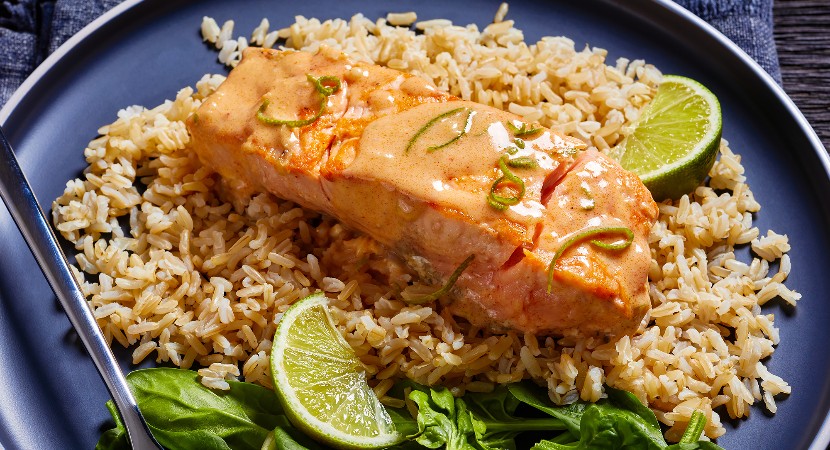Stephen King set the internet on fire with his method for microwaving salmon. I took a stand, and found my new favorite cooking method.
Last weekend I undertook an experiment to test my hypothesis that you can in fact cook a salmon filet in a toaster oven. What I found was both a statement of proof (yes, the salmon was cooked all the way through), and also something magical. Toaster oven salmon is surprisingly good. For two days after I made the salmon, I kept sneaking back to the fridge to have bites of cold fish between meals. My roommate even noticed, saying, "You must really like that salmon!" I did. And it's Stephen King's fault.
My exploration started when the renowned horror author tweeted his method for quickly cooking salmon in six simple steps:
King's salmon cooking instructions terrified much of the internet, with many Twitter users responding along the lines of "This is the shortest horror story he has ever written." And while I couldn't agree more, I do understand the purpose of his recipe. Microwaved salmon is quick, convenient, and a hearty source of protein — the holy trinity of an easy weeknight meal. This technique is also useful for people like me who, say, don't have air conditioning and are therefore reluctant to turn their oven on in the summer. So I set out to develop a method for cooking salmon that didn't require any preheating, active attention, or turning my apartment into a furnace.
Step 1: Firestarter
The first step in my salmon experiment was determining where I could improve on Stephen King's recipe; what did I not want to do? While using the microwave to cook salmon might be fast, I'm fairly confident that the super-high temperature would yield rubbery or weirdly textured fish. Wrapping the salmon in damp paper towels might make this even worse; it's likely that the sheets would stick to the salmon as they release steam in the microwave and ultimately leave a paper-towel texture on the exterior of the filet. But really, the greatest misstep in King's recipe is the lack of salt. No salt! Everything needs salt. So if all I did was add salt to this microwaved salmon, I'd already be (green) miles ahead of my favorite horror author.
Step 2: It (Is Time to Cook Some Salmon)
Let's start with my seasoning. After patting dry two salmon fillets and sprinkling them with salt, I mixed one tablespoon each of soy sauce, vegetable oil, and rice vinegar in a small bowl. Why did I choose these ingredients? Well, based on his tweet and our chosen career paths, I like to think I'm a better cook than Stephen King. No disrespect to olive oil and lemon juice, these are a classic combo, but I wanted something just a little more exciting. I brushed the three-ingredient marinade onto the salmon filets (and by brushed I mean rubbed the marinade on with my hands, because I don't own a pastry brush), and transferred them to a piece of foil. Salmon and foil went into the toaster oven, and I turned the temperature dial to 400°F.
Step 3: If It Bleeds (Then Your Salmon Might Not Be Done)
At this point let me assure you that if my toaster oven is capable of cooking salmon, then so is yours. My decrepit-but-beloved toaster oven came with my small Brooklyn apartment, and I truly have no idea if it actually reaches 400°F when I tell it to. My roommate says that our toaster oven is "incredible," but she has also never had one before, so how would she know? All I know is that it dries out my toast too much, and I can't get the grease stains off the bottom of it. After 20 minutes at (allegedly) 400°F, I checked my salmon. The easiest way to tell if salmon is done is by pressing it with a fork or your finger; if the flesh flakes easily, it's ready. But for the purposes of this research, I also took the internal temperature with a thermometer. At 147°F, my toaster oven salmon was two degrees above the FDA's recommended safe cooking temperature.
Step 4: The Shining (Results)
It merits pointing out that the toaster oven method did not yield crispy skin. You likely won't get this from just baking or roasting salmon either. For truly crispy skin, you need to sear the fish skin-side down on the stove top or finish it under a broiler. This was a consequence that I accepted. Surprisingly enough though, the salmon appeared to have been cooked fairly gently. There was a minimal amount of albumin — that white protein you see around cooked salmon — which means that it wasn't hammered with too much heat too quickly.
I served my salmon over sushi rice, with some sliced cucumbers, Kewpie mayo, and chili crisp (because I'll take any excuse to feel like TikTok star and salmon aficionado Emily Mariko). The quick marinade added enough flavor to the fish, and it was, genuinely, the most moist and tender salmon I've made at home. I consulted my roommates as unbiased taste testers, and we reached a consensus: Toaster oven salmon is the unexpected non-recipe recipe that we need in our lives. So if you ever find yourself facing a wave of hanger that could rival Cujo in its intensity, may I suggest turning to the toaster oven to relieve your Desperation.
This article was written by Merlyn Miller from Food & Wine and was legally licensed through the Industry Dive Content Marketplace. Please direct all licensing questions to legal@industrydive.com.







